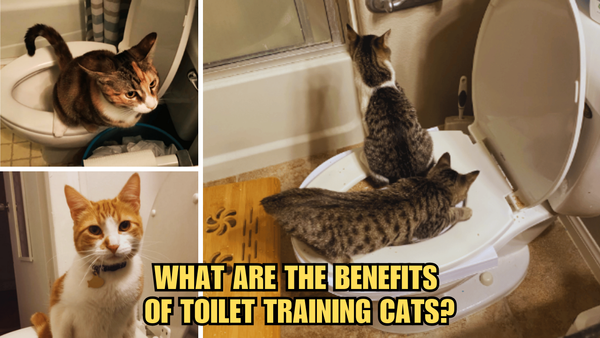Key Takeaways:
- Feasibility and Patience: Training a cat to use the toilet instead of a traditional litter box is feasible but requires patience and consistent effort from the cat owner.
- Health and Safety: It's crucial to consider the cat's health and natural instincts during the toilet training process to ensure it's a safe and positive experience.
- Long-term Benefits: Successfully toilet-trained cats can lead to a cleaner home environment and potentially lower costs in terms of buying litter.
Training a cat to use the toilet is a concept that might sound more like a circus act than a feasible household strategy. Yet, many cat owners have turned this seemingly fanciful idea into a reality. But how hard is it, really, to train a cat to use the human toilet? Let's dive into the nitty-gritty of turning your feline friend into a toilet-using sophisticate.
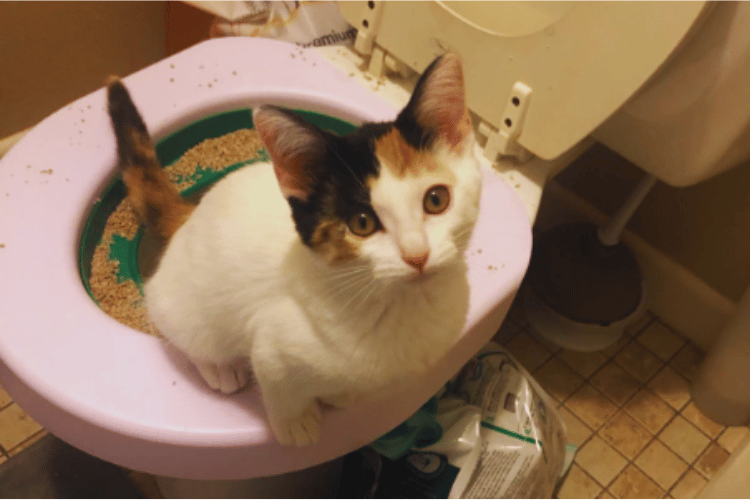
Understanding Your Cat's Instincts
Cats have natural instincts that guide their behavior, including their elimination habits. In the wild, cats tend to bury their waste to hide their scent from predators and other threats. This instinct is what makes them receptive to using litter boxes in a domestic setting. Transitioning from a litter box to a toilet requires altering these natural instincts, which isn't always straightforward.
The Right Age to Start
The best time to start toilet training your cat is when they are still a kitten. Kittens are generally more adaptable and open to learning new behaviors. However, this doesn't mean older cats can't learn new tricks. With the right approach and techniques, even senior cats can be taught to use the toilet, although it might take a bit longer.
Choosing the Right Equipment
Before you begin, you'll need some specific equipment. Products like the Litter Kwitter or similar toilet training kits can help ease the transition. These kits usually come with a series of rings or trays that fit over the toilet seat and gradually teach your cat to perch on the rim of the toilet bowl.
Step-by-Step Training Process
The toilet training process involves several stages, starting with moving your cat’s litter box closer to the bathroom. Over time, you raise the height of the litter box to level with the toilet seat, helping your cat get used to the new height for doing their business.
Gradual Transition
Once the litter box is in the bathroom and your cat is comfortable with the setup, the next step involves using a training seat that fits over the toilet bowl. Start with a small hole in the center, which gradually gets larger as your cat grows more accustomed to the idea of not having litter under their paws.
Monitoring Progress and Health
Throughout the training process, it’s vital to keep an eye on your cat’s behavior and health. Changes in elimination habits can indicate stress or discomfort. Additionally, watch for signs of urinary tract infections or other health issues, as these can sometimes be exacerbated by changes in toileting habits.
Behavioral Considerations
Not all cats will take to toilet training, and it's important to be mindful of your cat's preferences and comfort. Some cats may feel insecure or exposed using the toilet, which can lead to anxiety or behavioral issues.
The Comedic Trials of Cat Toilet Training
The Unexpected Hazards of a Cat on the Throne
Imagine the scene: you've just finished your morning coffee, and you're about to use the bathroom when, surprise! Your beloved feline is perched on the toilet, giving you a look that says, "Occupied!" Training your cat to use the actual toilet can lead to some humorous bathroom scheduling conflicts. While cat toilet training might save on cat's litter box expenses and the mess of cat's waste on the bathroom floor, it introduces a new challenge of negotiating toilet time. Remember, if you live with more than one pet, you might just find a queue forming outside your bathroom door each morning!
The Curious Case of the Midnight Splash
There's nothing quite like being jolted awake at 2 AM by the sound of splashing water, only to realize it's just your cat failing its latest attempt to balance on the toilet lid. While the goal is to have toilet trained cats that can manage their needs in a human loo, the journey there can be filled with late-night mishaps and unexpected waterworks. Cats are known for their grace, but the slippery surfaces of a toilet can prove challenging even for the most agile feline. Plus, if your cat's weight is on the lighter side, the sudden seat movement might just turn their routine pee into a pool party!
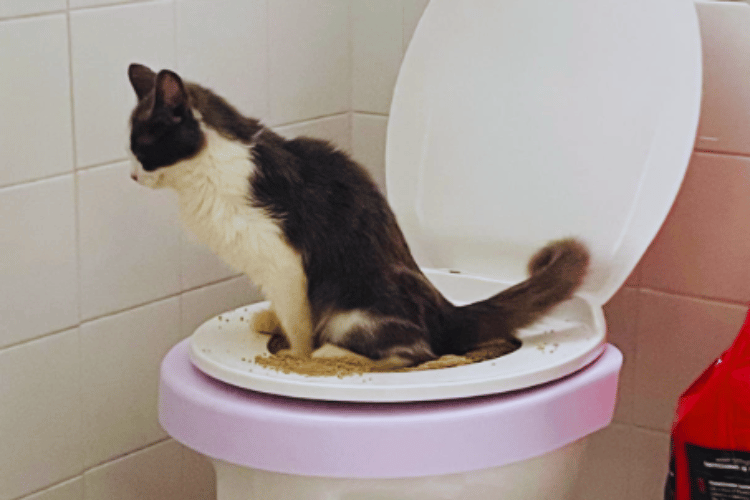
The Great Toilet Paper Caper
When you decide to toilet train your cat, be prepared for the Great Toilet Paper Caper. Cats are curious creatures, and the roll of toilet paper hanging so temptingly next to the throne can prove too much to resist. Imagine waking up to find your bathroom looking like the aftermath of a ticker-tape parade. While it's hilarious to see your feline friend frolicking in the chaos, it's less amusing to clean up. This unexpected side effect of toilet training your cat might have you reconsidering the good old cat's litter box.
Moreover, the toilet paper isn't just for shredding; some cats find it a comfy spot for a nap or even a sneaky hiding place. This can lead to some amusing but startling moments, especially when guests use your bathroom only to find a fluffy tail sticking out from behind the toilet paper. While these antics are endearing, they underscore the unpredictable nature of transitioning from a traditional cat's litter box to a human toilet. Always keep an extra roll hidden away, unless you want to explain the "cat-made confetti" to your visitors!
The Saga of the Selective Flusher
Have you ever wondered if a toilet-trained cat might just be a bit too picky about where it does its business? Imagine the scene: your feline, having mastered the art of the human toilet, now refuses to use it unless the seat is warmed and the lighting is just right. Training cats to use the toilet can lead to some humorous bathroom etiquette. For instance, some cats might only use the toilet if it's free of any offending odors—yes, they might just be more particular than humans!
On the other hand, there's the issue of teaching the proper flushing technique. While some cats might learn to flush, others turn into phantom flushers, mysteriously activating the toilet at the most unexpected times. This could lead to increased water bills and the occasional midnight scare when the toilet decides to flush itself. It's a quirky side effect of having a toilet-trained cat that no one really warns you about. Training boxes and flushable litter were supposed to make life easier, but who knew they'd lead to such peculiar bathroom habits?
The Enigmatic Art of Kitty Potty Negotiations
When embarking on the noble quest of potty training your feline, you might find yourself more of a diplomat than a trainer. Picture this: you've set up the perfect training box, complete with a strategically placed kitty door, and yet, your cat gazes at it with the disdain of a royal dismissing their least favorite courtier. Convincing a cat to abandon their litter box for the sleek, water-filled throne involves understanding the cat's natural instincts and a lot of persuasive kitty treats.
Negotiating with a cat over toilet usage is akin to brokering an international treaty. Each party (you and your cat) has their non-negotiables: yours is less litter around the house, and your cat's is maintaining their dignity and comfort. You'll find yourself making concessions—maybe installing a larger hole initially or leaving the bathroom light on for midnight visits. Remember, in the grand scheme of cat ages, transitioning from a litter box to a toilet is a significant lifestyle upgrade, akin to humans discovering the joys of high-thread-count sheets.
The Mystery of the Disappearing Poop
Have you ever wondered where your cat's poop magically disappears to after a successful toilet training session? Well, it's not quite Hogwarts, but it does involve some clever maneuvering. When you potty train your cat, you're signing up for a detective role in the curious case of the vanishing waste. Unlike the traditional cat's litter box where the evidence of their deeds remains until you intervene, a toilet-trained cat leaves little behind, making you wonder if they ever went at all!
This disappearing act isn't just amusing—it's a clean and odor-free way to manage your cat's waste. However, it's crucial to keep an eye on what's normal for your cat's health. Regularly checking even after they've been trained can help spot any changes in their habits or health issues early. Veterinary medicine emphasizes the importance of monitoring your cat's poop for signs of health, so don't let the flush lull you into complacency!
The Whisker Whisperer's Guide to Toilet Training
Have you ever tried whispering sweet nothings into your cat's ear hoping they'll understand the benefits of using the toilet? Well, training your cat to ditch the litter box and embrace the porcelain throne is not just about sweet talk. It's about tapping into your cat's natural instincts. Cats are clean creatures by nature, and the allure of a spotless surrounding area can be quite tempting for them. By using their preferences to your advantage, you can make the toilet an appealing option, minus the mess of scattered litter.
However, don't be surprised if your feline friend gives you a look that says, "You want me to do what, where?!" Understanding and respecting your cat's instincts are crucial. They are creatures of habit and changing their routine can be a daunting task. It's not just about training them to use the toilet but also ensuring that this new habit aligns with their natural behaviors and comfort. So, while you might be ready to say goodbye to the cat's litter box, ensure you're introducing this change in a way that respects your cat's pace and preferences.
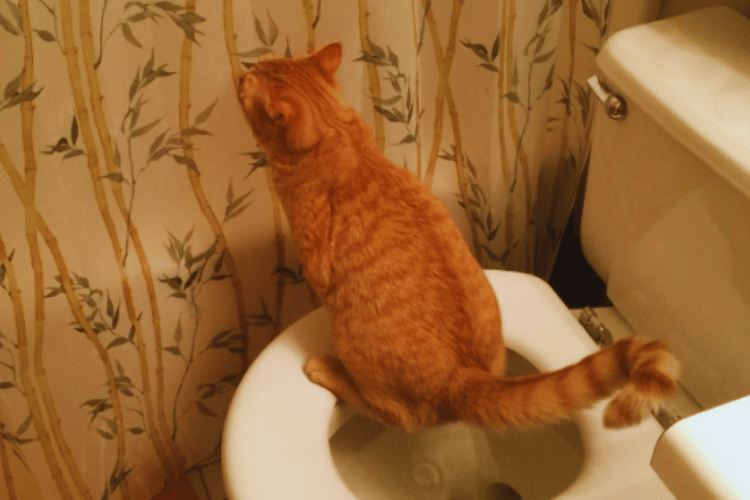
The Perplexing Puzzle of Poop Placement
Have you ever wondered about the strategic decisions involved in transitioning from a cat's litter box to a royal flush scenario? Well, it's not just about teaching your furry friend where to place their waste; it's about understanding the cat's natural instincts. Cats are naturally inclined to cover their waste, which helps them hide their scent from predators. When you train your cat to use the toilet, you're asking them to ignore these deep-seated instincts. It's like convincing a seasoned chess player to forget the rules of the game and play checkers instead!
Moreover, the placement of the cat's poop becomes a daily mystery tour. One day you might find success with your cat using the toilet, and the next day, it's back to the drawing board with surprises hidden in secret corners of your home. This unpredictability can be amusing yet frustrating as you navigate through the labyrinth of your cat's potty preferences. It's essential to keep a vigilant eye and a good sense of humor as you both learn the new rules of the bathroom game.
The Weighty Whisker Worry
When embarking on the journey to train my cat to use the toilet, one must not overlook the importance of monitoring the cat's weight. This isn't just about ensuring they're not sneaking extra treats; it's about understanding how weight impacts their ability to balance on the toilet seat. Imagine the acrobatic skills required for a fluffy feline to perch precariously on the rim! For heavier cats, this might seem like a circus act gone wrong, leading to potential falls or a reluctance to use the toilet altogether.
In addition to the balancing act, a significant change in your cat's weight could indicate health issues that might be exacerbated by the stress of toilet training. It's crucial to keep a close eye on your cat's health and weight throughout this process. Regular vet checkups and a watchful eye can ensure that your toilet training ambitions don't compromise your beloved pet's well-being. After all, the goal is to enhance their hygiene and convenience, not to turn potty time into a stressful ordeal.
The Balancing Act: Monitoring Your Cat's Health and Toilet Habits
When you embark on the journey to train your cat to use the toilet, it's vital to keep a close eye on your cat's health. Transitioning away from a litter box means you might not see their waste as frequently, but it's important to ensure everything is normal. Changes in your cat's poop can be an early indicator of health issues. Regularly check to ensure that their waste looks normal and keep an eye out for any signs of distress or discomfort that could suggest health problems.
Moreover, monitoring your cat's weight is also essential during this transition. The change in routine and possibly even a slight stress from learning a new skill can affect their eating habits. Make sure your cat is maintaining a healthy weight and adjust their diet and training schedule as needed. Remember, the goal is to make life easier and healthier for both of you, so keep the treats handy but also keep the scales close by to ensure your furry friend stays in tip-top shape throughout this toilet training adventure.
The Purr-spective of Potty Training Peers
Imagine the scene: your cat has just mastered the art of using the human toilet, and it's time to show off this incredible feat to other cats in the neighborhood. But how do other furry friends react to such an unnatural choice? Well, cats being the territorial creatures they are, might not take kindly to seeing a fellow feline abandon the age-old litter box. It's like watching someone eat pizza with a fork and knife—bizarre yet fascinating!
In the realm of cat taught behaviors, using the toilet is quite the party trick that can either impress or confuse their peers. While your cat might be the pioneer in toilet tactics, remember that each cat's natural instincts vary. Some might be intrigued and consider giving it a try, while others might scoff and stick to their trusted litter boxes. Always consider your cat's comfort and willingness when introducing new routines, especially if you have multiple cats sharing the same space.
The Chronicles of the Litter-less Lavatory
Embarking on the journey to train cats to use a human toilet can lead to some unexpected yet humorous scenarios. Imagine waking up in the middle of the night to the sounds of splashing only to find your cat has turned the toilet into a personal water park. The transition from cat's litter box to toilet isn't just about training; it's about adapting your entire home environment in such a way that supports your cat's health and hygiene needs without turning your bathroom into a splash zone.
Moreover, the absence of a litter box means you might encounter cat feces in places you'd least expect as your kitty learns the ropes of their new bathroom. It's a process that might test your patience, but it also leads to less litter used and more space in your home. Plus, watching a toilet trained cat confidently navigate their new bathroom is a sight that can make all the comedic mishaps along the way worth it. Just be sure to keep a close eye on your cat's weight and health, as changes in bathroom behavior can sometimes indicate issues like a urinary tract infection.
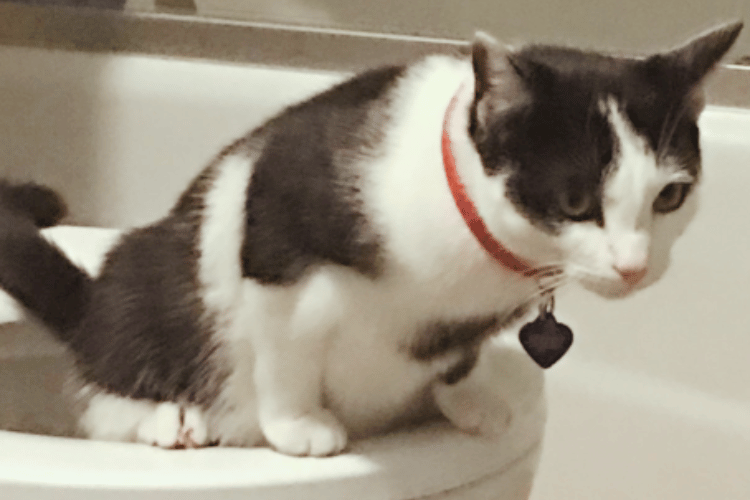
The Diplomatic Discussions with Dogs
Introducing a toilet-trained cat to a household with dogs can lead to some amusing negotiations. Dogs, generally being less fussy about their bathroom habits, might find the whole concept of a cat using the human toilet both fascinating and slightly offensive. "Why does the cat get the throne, and I get the great outdoors?" seems to be a common canine query. This can lead to some humorous stand-offs at the bathroom door, with the cat inside and the dog pondering the injustice of it all from the other side.
Moreover, if you thought training cats was a challenge, try explaining to your dog why the cat’s waste gets to disappear with a flush, while theirs does not. Dogs might start expecting their own kitty doors into the bathroom or, worse, attempt to use the toilet themselves, leading to all sorts of comedic, yet potentially messy, misunderstandings. It's a delicate dance of pet diplomacy, where the humane society never quite prepared you for the interspecies bathroom debates that ensue in a multi-pet household.
The Litter Box Loyalty Test
Believe it or not, some cats just can't let go of the old ways. Introducing a new kitten to the sophisticated art of using a human toilet can sometimes backfire spectacularly. Picture this: you've spent weeks patiently demonstrating the finesse of the flush, only to find your kitty still prefers the good old-fashioned litter box. It seems that the cat's natural instincts can sometimes override even the most dedicated toilet training efforts. This loyalty to the litter can be both a comedic and a slightly frustrating experience for cat owners.
What's more, transitioning older cats who have spent years appreciating their litter box setup can be like negotiating a peace treaty. Some cats might use the toilet in a protest-free manner during the day but revert to their old litter habits at night. This split personality in potty preferences shows that while you can often teach an old cat new tricks, their allegiance might still lie with the familiar. So, if your senior cat gives you a look that says, "What's wrong with the old way?" maybe it's time to respect their seasoned preferences and keep the litter box around a bit longer.
The Quirky Side-Effects of Ditching the Litter Box
From Litter Kicker to Toilet Tactician
Transitioning from a litter pan filled with biodegradable litter to balancing on a narrow toilet seat can make your cat feel like it's part of a circus act. Most cats have a natural instinct to dig and cover their waste, so convincing them to abandon this instinct and adopt a whole new method can lead to some amusing training sessions. Picture this: your cat, paws outstretched, trying to find someplace to hide its business on a shiny porcelain surface. It's a significant change, and while some might adapt, others might just miss the mark—quite literally!
The Tale of the Phantom Flusher
One of the lesser-known side effects of having a toilet-trained cat is the mysterious case of the phantom flush. As your cat becomes more adept at using the human toilet, don't be surprised if you start hearing the toilet flush at odd hours. While it's unlikely that your cat has learned to actually flush, more curious or playful cats might accidentally trigger the mechanism, especially if they're fascinated by the swirling water. This can lead to increased water bills and the occasional scare when you hear flushing in an empty house. Always a fun story to share, but perhaps not so friendly for your water conservation efforts!
Environmental Impact
One of the motivations for toilet training cats is the environmental aspect. Traditional litter, especially clay-based and silica litters, are not biodegradable and contribute to environmental waste. By toilet training your cat, you might reduce the need for such litter.
Cost Implications
Over the lifetime of a cat, the cost of kitty litter can add up. Toilet training your cat could potentially save you money in the long run, although the initial investment in training supplies and potential plumbing issues from accidents should be considered.
Social and Logistical Considerations
Having a cat that uses the toilet can be a talking point and is often seen as a novelty. However, logistical issues such as keeping the bathroom door open and managing multiple cats or guests can pose challenges.
The Role of Patience and Consistency
Patience is key when toilet training a cat. The process can take several weeks to months, and consistency in approach and encouragement is crucial for success.
When to Stick with the Litter Box
For some cats, particularly those who are older or have mobility issues, sticking with a traditional litter box might be the best option. It’s important to prioritize your cat’s comfort and well-being over the convenience or novelty of toilet training.
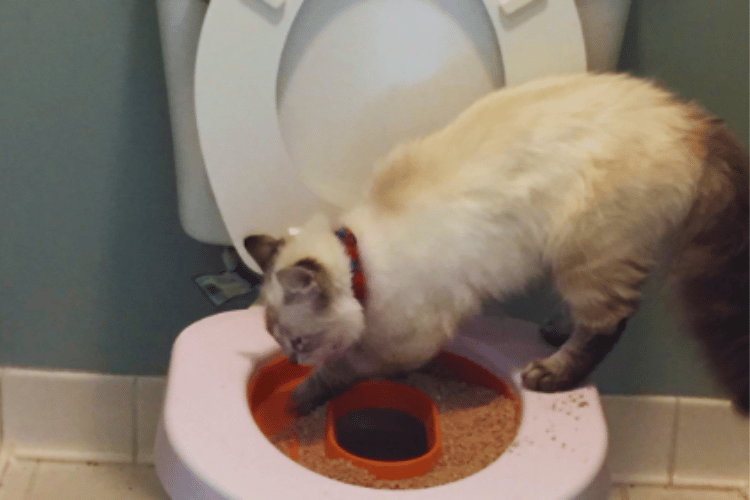
Summary
Training a cat to use the toilet is a challenging but potentially rewarding endeavor. It requires understanding your cat's instincts, patience, and a gradual training process. While not all cats will adapt to this change, those that do can contribute to a cleaner home and potentially lower ongoing costs in kitty litter.
FAQ
Q1: How long does it usually take to toilet train a cat?
A1: The duration varies depending on the cat's age, temperament, and consistency of the training, but it typically takes between 3 to 6 months.
Q2: Are there any health risks associated with cats using the human toilet?
A2: There can be risks such as increased stress or the potential for more frequent urinary tract infections. It's important to monitor your cat closely and consult with a vet if you notice any health changes.
Q3: Can toilet training affect my cat's behavior?
A3: Yes, some cats may feel vulnerable or stressed by using the toilet, which can lead to behavioral changes. It's important to proceed slowly and revert back to a litter box if your cat seems distressed.
Thank you for visiting LegitLists we hope this helps you make a legitimate choice!






